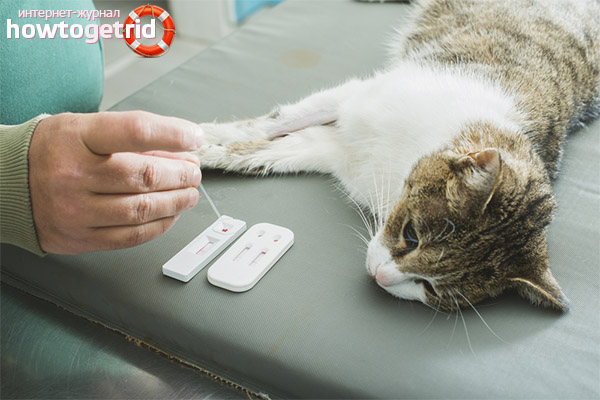The content of the article
Pets can, like people, suffer from various diseases. And there is nothing surprising if the pet suddenly began to hurt with something. This is not very pleasant, and the owner of the animal will have to work hard to completely cure their pet. Today, science knows everything about the overwhelming majority of diseases that plague cats, and many methods have been developed for treating all cat diseases. One of them is called haemobartonellosis, and it is about her that the story will go.
Hemobartonellosis is a very unpleasant disease, popularly called "feline anemia." What kind of ailment is it, what does it look like, and how to treat it?
A disease with such a long name is a serious danger for a cat.For most (slightly more than 60 percent) animals, the course of the disease occurs in a latent form, without any manifestation. But some external factors (suppose stressful situations, vaccinations, other diseases, etc.) provoke the activation of the disease.
Anemia begins to develop, in its background some other diseases and problems with well-being arise. If you do not start treating the animal in time, then there are quite a few deaths - almost a third of the patients die.
Causes of infection
The disease is spread mainly by ticks and fleas. Consequently, if a cat is bitten by one of these parasites, in whose body an infection is found, then the chance of being infected in an animal is quite high. But there are other reasons why a pet can catch an intractable this serious infection.
- Contact with an infected animal. Suppose a pet went for a walk and fought with a stray cat suffering from this disease. During the fight, he was repeatedly bitten and scratched, and an infection in his wounds.
- It infects the mother suffering from this disease.If the parent is already infected and did not receive the necessary treatment in time, then the probability of transmission of the disease to the born kittens is very high. The disease is transmitted through the placenta during childbirth, as well as through breast milk.
- When medical veterinarians transfuse blood. This reason is not very common, because the transfusion procedure is rather rarely required and is also performed infrequently. Yes, and the blood is carefully checked, but such cases were.
In male cats, infection with haemobartonellosis occurs more often than among females. The reason is simple: nature has more aggression in male cats, than in females, so they are much more likely to conflict and fight with relatives, while cats are more peaceful and tidy. By the way, the outbreak of infection reaches a peak in the autumn period - at this time of the year more than 30% more representatives of the feline tribe are infected than in spring and summer.
Symptoms of the disease
Infectious anemia develops in cats not rapidly, but gradually, and for the symptoms to appear, it takes some time. It takes 10-12 days for the owner to notice that the animal showed some noticeable signs of the disease.
Symptoms that appear in all sick animals are the same.The owner will definitely see that:
- The cat is rapidly lost.
- The pet's behavior has changed a lot - it has become sluggish, apathy has come, with a minimum of movements it quickly tires, and in general it almost does not run.
- Breathing quickened, the pulse became more frequent.
- Pet every day less and less eats, until the full refusal of visits to the bowl with food.
- Urine darkened (noticeably in domestic cats living in the house).
When these signs are detected, the owner needs to remember - have ticks been found in a pet not so long ago? Are there any fleas on contact with him? Were there any contact and fights with street brothers or dogs? By answering these questions, the owner will be able to more easily determine what is happening with the animal.
Ways to self-identify symptoms
If the above changes in the cat are noticeable, then you should make sure whether the infection with hemobartonellosis really occurred, or there are other reasons. To do this, you must carefully examine the cat and look for some more symptoms that indicate the presence of this particular disease.
- Skin and coat. Disheveled and lost shine wool characteristic of many diseases. And the changed skin color appears just at owners of the described disease. With anemia, the body suffers a lack of oxygen and it always affects the skin of the animal - it becomes lemon-colored, sometimes with an orange tint. The skin becomes taut, devoid of moisture and harsh.
- Mechanical damage. The presence of bites, deep and not very scratches or any wounds will tell if a cat could catch such a bad infection.
- Mucous membranes. It is necessary to open the mouth of the animal and carefully study the tongue and cat gums. If there is anemia in the cat's body, they should be pale.
- Temperature. With the chronic development of the disease, the cat has no fever. During an exacerbation, it may increase slightly, but it will not lead to a fever.
- Vote. When an animal is sick (no matter what), its voice sounds hoarse and with less intelligibility. A suffering cat tries to make sounds as little as possible. Therefore, this symptom is worth paying attention to - it will let know that the pet has definitely hit some ailment.
Diagnostic measures
The above-described procedures performed at home make it possible to notice that changes in the pathological nature have taken place with the pet. But only a doctor can diagnose more accurately, so you should immediately contact a veterinarian.
The specialist will also see that the color of the skin has changed, the mucous membranes have turned pale, will pay attention to other symptoms and signs, but a blood test is of no small importance here. Also, the doctor will make a smear and examine it with a microscope. There it is possible to see if there is harmful microflora in the body of the pet. After studying the tests done, the veterinarian will tell you exactly what the animal is ill with and will prescribe a treatment, which will be used.
Hemobartonellosis treatment
Therapeutic therapy is developed individually for each sick animal. The doctor necessarily takes into account all the signs of the disease, the frequency of their manifestation and whether there are concomitant diseases and problems.
The doctor carefully thinks over the scheme according to which drugs are taken, in what dosage, and the duration of the course of treatment.
The essence of treatment is to destroy the parasites that cause the disease. Accordingly, the owner will have to give the patient medications that destroy pathogenic microflora. In addition, other medications that restore the functionality of the body and support its vital activity are mandatory.
Therefore, the treatment is carried out in a complex and includes the following drugs:
- Antibiotics. Their role is that they fight the infectious agent.
- Drugs that contain iron help to bring blood to a normal state.
- Droppers - used for dehydration of the animal.
- Vitamins (in injections and tablets) activate the immune processes of the pet.
- Sedatives and sedatives - normalize the nervous system, inhibit the development of stress conditions.
- Prednisolone - is used for the excess of red cells in the blood.
- Blood transfusion - required for total infection. Updating the blood, you can kill most of the pathogens, and antibiotics will cope with the rest.
Under no circumstances can you proceed to treatment,without consulting with medical specialists! Only they know about the methods of dealing with such dangerous illnesses, such as hemobartonellosis. Otherwise, a beloved cat may not become any better, but worse, and the case may well end in death.
Methods for the prevention of hemobartonellosis
It is much easier to make it so that the disease does not hit the pet, than to spend time, money and strength for its treatment. To prevent the occurrence of haemobartonellosis is quite realistic and capable of everyone who contains cats. It is not as easy as with dogs - they are amenable to training and are able to be obedient, and cats are more freedom-loving and capricious. But quite doable.
It is recommended to do the following:
- If possible, protect the pet from visiting the street, in extreme cases, try to control his walks.
- To exert forces so that the cat does not come into contact with stray animals. Because it is they who often carry all sorts of infections and can "share" it with a pet.
- Make an effort to properly feed the cat.If the owner does not know what exactly to give to the shaggy housemate, you can ask knowledgeable people or read the relevant literature, which is a lot on the Internet. Be sure to include in the cat diet vitamins, because they strengthen the immune system. As with good immunity, the animal will independently defeat any infection.
- For domestic cats, constant movement is very important. It is not necessary to limit the pets in that they run - it is necessary for health.
- Experts recommend always using anti-worms and fleas, do not neglect the means of protecting against ticks. In their quality there can be various kinds of special shampoos, creams, some aerosols, a flea collar can be put on a cat and so on - in pet stores there is a great choice.
- It is required when keeping a cat to strictly observe hygiene - regularly change the toilet, use good fillers for the pot.
- When acquiring an animal from hands (say, in a nursery or at an exhibition), it is useful to check the health of the parents and whether they are vaccinated.
In general, it is completely possible for a person to do everything so that the cat does not become infected with any infection.Although this is not always the case, when you discover your four-legged friend’s disease, you don’t need to panic and, worst of all, leave it as it is, in the hope that the situation will resolve by itself. It is on the actions of the owner very much depends, in particular - whether the pet will recover and how quickly. Here there is only one recommendation - to contact a veterinarian as soon as possible so that he looks and prescribes treatment. The most important thing is that a person cannot become infected with haemobartonellosis, therefore one should not protect oneself from contacts with an ill, but beloved tailed household.
Video: Infectious diseases of cats and dogs - what is important to know?












To send